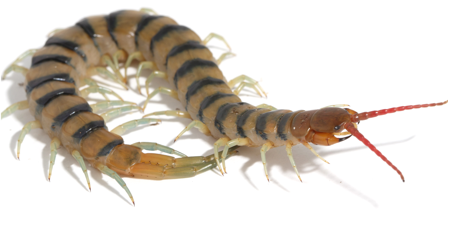| |
There are hundreds of thousands of poisonous creatures in the animal kingdom, usually known for the delivery of venom in order to kill or severely injure predators and/or prey.
Indeed, many species of snakes, spiders, and insects (among other animal families) are known for stings and bites that bring great pain to their victims. It is perhaps unexpected, then, that venom has become a topic of great interest amongst researchers seeking to alleviate pain. In fact, new findings by a collaborative team of researchers in China and Australia might one day result in new treatments for chronic pain based on venom produced by the Chinese red-headed centipede, Scolopendra subspinipes mutilans.

Picture of the Chinese red-headed centipede, Scolopendra subspinipes mutilans.
The ability to feel painful sensations is a critical process that allows for survival. For example, the burning sensation on your skin when you get too close to something hot warns you not to get closer. Similarly, the painful numbing of your fingers and toes in cold weather reminds you to put on more layers or get to a warmer place. For some people, though, sensations of pain persist long after an initial injury (or sometimes for no apparent injury), leading to a condition of chronic pain that can be both uncomfortable and debilitating. Approximately twenty percent of the population of the United States, including an increasing number of elderly patients, suffers from chronic pain.
It is perhaps unexpected that venom has become a topic of great interest amongst researchers seeking to alleviate pain.
Chronic pain can be very difficult to manage and/or treat because there is often no clear source of pain. One important clue, however, was provided by a family of street theater performers in Pakistan who could accomplish astounding stunts because
they were literally incapable of feeling pain
. Sadly, several members lost their lives because they couldn’t receive the warnings provided by the body’s normal response to pain.
As news of this family spread around the world, researchers were able to study the family and conduct genetic analyses using blood samples from some of the performers. The analyses indicated the individuals who could not feel pain had a specific genetic mutation in the voltage-gated
sodium ion channel
known as
Nav1.7.
Several years after this discovery, Dr. Glenn King of the University of Queensland, Australia, Drs. Lai Ren and Mingqiang Rong at the Chinese Academy of Sciences were studying the sodium channel Nav1.7 as a target for new pain treatments. Finding a treatment that only worked on this sodium channel was difficult until a team headed by Dr. Ren studied the venom from the Chinese red-headed centipede.
A PhD student, Shilong Yang, from Dr. Ren’s laboratory at the Kunming Institute of Zoology, Chinese Academy of Sciences, purified chemical components from the red-headed centipede venom using
high-performance liquid chromatography
(HPLC). Each component was then tested in experiments on pain-sensing neurons. Shilong found that one component called µ-SLPTX-Ssm6a was very selective for the Nav1.7 channel and reported on this finding.
In mice, the venom was found to be as effective as
morphine
to relieve pain.
These researchers have conducted a series of experiments to determine how µ-SLPTX-Ssm6a works to alleviate pain. They have tested µ-SLPTX-Ssm6a in mouse models to determine the type of pain it could alleviate and any potential side effects. In mice, the venom was found to be as effective as
morphine
to relieve pain. The next steps for this research are to test µ-SLPTX-Ssm6a in more sophisticated animal models that better replicate human pain states. If all goes well, their research might provide a new treatment for the alleviation of chronic pain within a decade.
Dr. Glenn King is Professor and Laboratory Head in the Division of Chemistry and Structural Biology at the University of Queensland in Queensland, Australia. His research focuses on the discovery and development of molecules from the venoms of spiders and centipedes that can be used as treatments for stroke and chronic pain. In his spare time, Dr. King likes to bicycle, swim and run and spend time with his family.
Dr. Lai Ren is a Professor and Laboratory Head for the laboratory of functional proteomics of native medicines at Kunming Institute of Zoology, Chinese Academy of Sciences. His research focuses on the structures and functions of bioactive peptides and proteins from animal venoms such as snakes, centipedes, frogs, wasps, scorpions, spiders, and horseflies and drug development. When not in the laboratory, he plays football, and likes climbing and spending time with his family.
Dr. Mingqiang Rong is a biochemist in the laboratory of functional proteomics of native medicines at Kunming Institute of Zoology, Chinese Academy of Sciences. His research focuses on toxins acting on ion channel from spiders and centipedes. He does his best to develop the toxins into therapeutics. He spends his spare time reading or traveling.
To Learn More:
- Yang, S. et al. 2013. “Discovery of a selective Nav1.7 inhibitor from centipede venom with analgesic efficacy exceeding morphine in rodent pain models.” Proceedings of the National Academy of Sciences USA, 10, 17534–17539.
- King, G. 2011. “Venoms as a platform for human drugs: translating toxins into therapeutics.” Expert Opinion in Biology Therapeutics, 11: 1469–1484.
For More Information:
- American Chronic Pain Association. http://theacpa.org/
- National Institute of Neurological Disorders and Stroke. http://www.ninds.nih.gov/disorders/chronic_pain/chronic_pain.htm
- Psychology Today: Chronic Pain. http://www.psychologytoday.com/basics/chronic-pain
Written by Rebecca Kranz with Andrea Gwosdow, PhD at www.gwosdow.com
HOME | ABOUT | ARCHIVES | TEACHERS | LINKS | CONTACT
All content on this site is © Massachusetts
Society for Medical Research or others. Please read our copyright
statement — it is important. |
|
|

Glenn King

Lai Ren

Mingqiang Rong

Shilong Yang

Julie Klint

Eivind Undheim
To learn more about voltage-gated ion channels, go here.

Everything you ever wanted to know about the Chinese red-headed centipede
Sign Up for our Monthly Announcement!
...or  subscribe to all of our stories! subscribe to all of our stories!

What A Year! is a project of the Massachusetts
Society for Medical Research.
|
|

